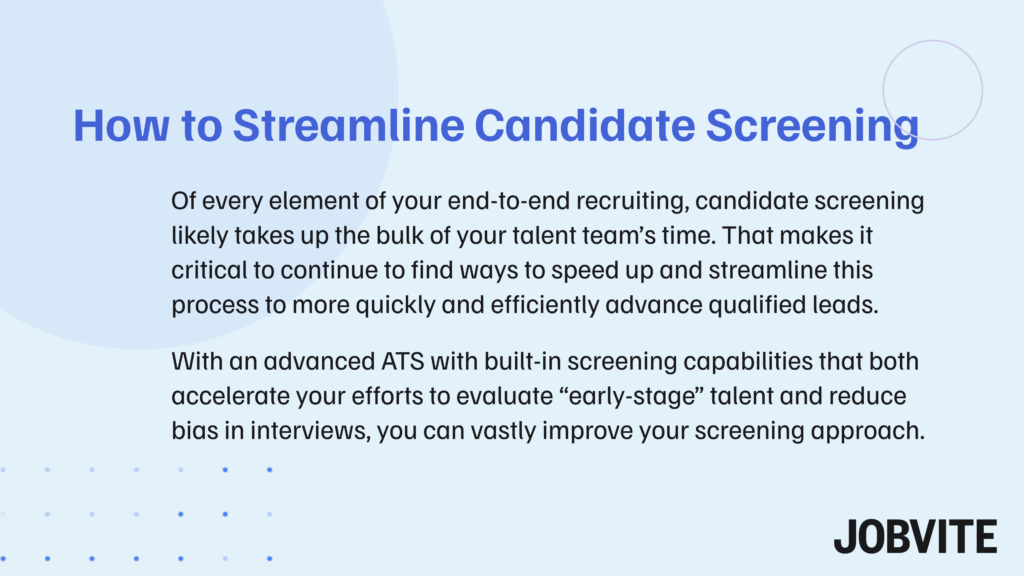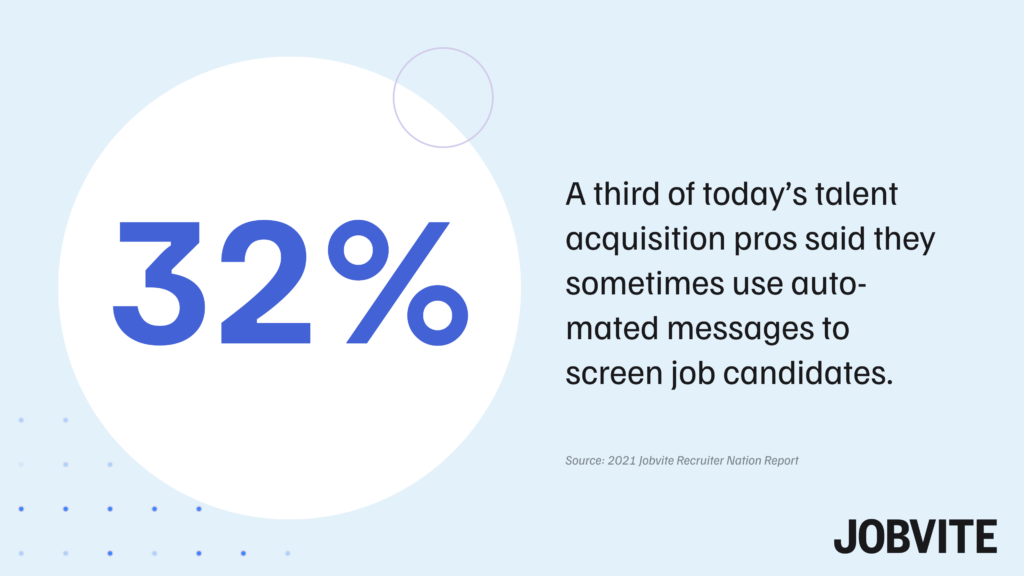With top talent considered a scarce resource for enterprises today, many recruiters at large-scale organizations like yours are having to determining the best candidate screening approach to use:
That is to say, they want to know if they should “screen in” or “screen out.”
Traditionally, screening out — or eliminating candidates because they don’t meet specific criteria — has been the default practice of hiring teams and recruiters.
But, with recent discussions on how quickly this can decrease the talent pool of incredibly competent candidates, industry leaders are trying a new approach.
Let’s examine both more closely to help you determine how to use one of the or both candidate screening processes to your advantage in what remains a challenging hiring environment.

Candidate screening option #1: “Screen out”
There is a time and place for screening out:
- Physicians obviously must have a medical degree.
- Accountants definitely need CPA certification.
- Truck drivers need a commercial driver’s license.
In some cases, it’s completely necessary to have firm, non-negotiable requirements for applicants.
To waste time on the interview process without them would be a disservice to you and the candidate. So, it’s entirely plausible to rule out leads without these specs at the application stage.
There are two occasions where screening out is entirely necessary:
- The first is in the search for candidates for a highly technical position as listed above. An ATS can filter out applications without these specific criteria. However, there’s a distinct difference between roles that require specific accreditation and roles that technically don’t require a certain degree or level of education.
- The second occasion where screening out is relevant is when a candidate cannot meet the basic needs of the role. If the role would put the candidate’s safety at risk, or they cannot meet the required physical demands of a job, they would likely be disqualified from the position. Likewise, if your role requires the candidate to be in person in California, but they’ve noted that they live in New York and are unwilling to relocate, then disqualifying or screening out a candidate makes sense. As long as your qualifiers aren’t discriminatory, screening out a candidate can be strategic move.
The biggest downfall to screening out is eliminating qualified candidates using the wrong metrics, which is a common mistake. There’s a difference between not having a commercial driver’s license (which is a requirement by law) and not having a bachelor’s degree for an entry-level position.
This is a slippery slope, to say the least.
Unconscious biases can sneak into this process and cause talent acquisition teams to use criteria, such as gender, ethnicity, or other factors irrelevant to the job description to screen candidates.
These biases can not only prevent you from finding the best candidates, but they can also stifle innovation, productivity, and employee engagement. Luckily, there’s an alternative to this approach.

Candidate screening option #2: “Screen in”
Screening “in” is commonly misunderstood and underused. This process, at its core, is a more inclusive approach to hiring that considers candidates who may bring refreshed experience, enthusiasm, and energy to your organization through their unique experiences.
Screening in versus screening out may simply involve broadening your criteria, such as indicating, “We’re looking for someone with a degree in Public Relations, but will also accept degrees in Journalism or Communications.” Furthermore, you may accept related experience in lieu of a degree altogether.
The screening-in process allows candidates to demonstrate their expertise or provide context to their application that’s often overlooked when hiring teams or recruiters default to screening applicants with two-dimensional criteria.
Perhaps your usual candidates possess a degree in sales, business, or economics.
If you limit your search results to only those particular degrees, you are likely to miss out on someone with a degree in engineering who could offer a fresh perspective.
If you’re concerned the candidate’s background doesn’t correlate seamlessly to the work at hand, consider a screening question within the application or a screening interview for further clarification and offer the chance for the candidate to illustrate their unique experience.
Companies embracing the screening-in approach will benefit from “hidden gem” potential candidates who may not have the traditional background, but will thrive in the position, nonetheless.
Rethinking the conventional criteria in which you screen job applicants and sourced talent is often the first step in increasing your quality of hire, saving time in your hiring process, and meeting specific hiring goals laid out by leadership during strategic planning sessions before the year began.
Using the right applicant tracking system to screen for suitable candidates now essential
From cover letter and resume screening and the initial phone interview with your sourcer, to in-person interviews with panelists and skills tests toward the end of the recruiting process, there are countless tasks that must be tackled just to advance prospects of interest all the way to the offer stage.
And these activities are best executed with a modern, advanced ATS that offers features and functionality that aid with every stage of recruitment life cycle.
Sure, there are other talent acquisition tools you’ll need to integrate with your ATS of choice (e.g., background check tools, HRIC/HCM systems, workplace collaboration and communication platforms).
That said, leading applicant tracking systems offer built-in capabilities that aid with nearly all facets of recruiting and hiring today — including and especially screening job candidates.
Consider Jobvite customer Noble Network of Charter Schools. The organization’s candidate screening efforts prior to investing in our TA suite left a lot to be desired. Notably, its talent specialists were forced to spend the bulk of their time screening using a mix of disparate tools.
That meant less time they could spend proactively sourcing talent on social media and other career communities, nurturing candidates already in their database, and analyzing their recent TA performance.
Now, Noble’s recruiters can screen engaged prospects right from Jobvite — and more quickly identify strong-fit individuals they want to move to the interview process and those they want to pass on.
“Looking back to life before Jobvite, we would spend 70-80% of our day screening applicants,” said Michele Ybarra, the former Manager of Selection and Hiring at Noble.
“Today that has dropped by at least 30%,” Michele added. “Now, I can focus on critical work that can move the needle for Noble, allowing my time to be more strategic and impactful.”
Less time spent on video and phone screens, and more time spent on work that matters. That’s what TA teams get when they use our powerful ATS as their primary full-cycle recruitment software today.
Find out how you can streamline and speed up your candidate screening process with Jobvite.





